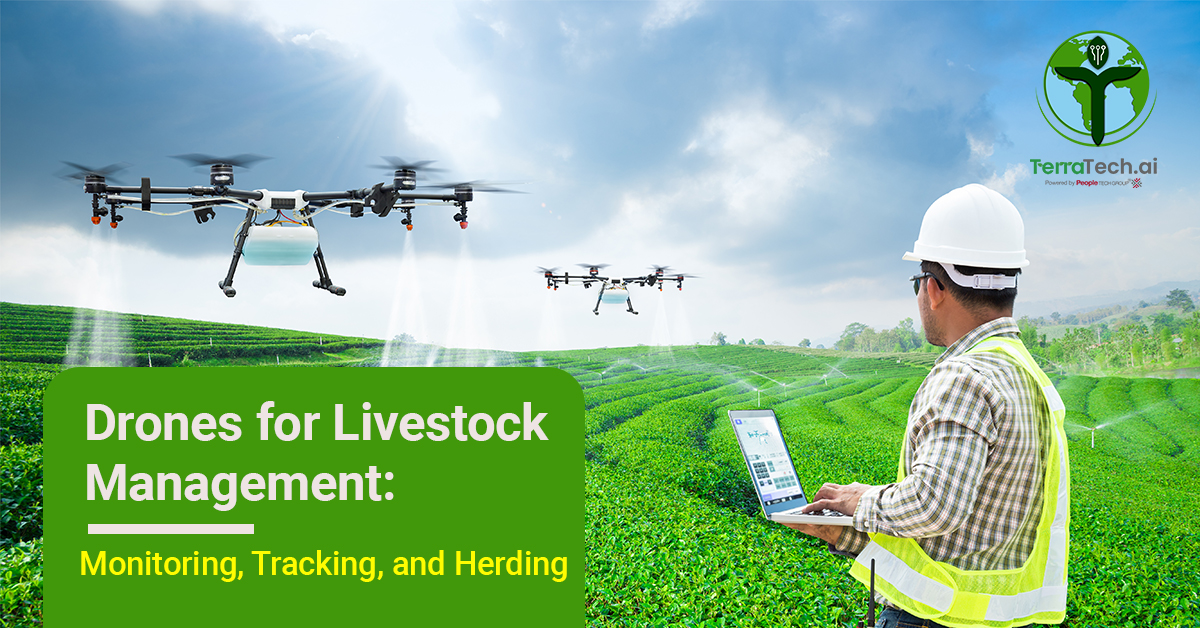Drones for Livestock Management: Monitoring, Tracking, and Herding
Introduction
The agricultural industry is constantly undergoing a transformation with the advancements in the modern technology world. Drone farming in agriculture is one such advancement that is making its way into the crop production industry. It helps farmers detect weeds, pests and nutrient deficiencies, if any. Besides its vast applications in crop monitoring, drone technology works excellently for livestock management as well. It holds the power to revolutionize livestock management through its extensive use cases.
Drones or unmanned aerial vehicles can monitor, track, and herd livestock accurately and efficiently using drone mapping and advanced drone sensors. Let us explore the use cases of drone technology in livestock management and its role in the effectiveness of farmers’ work and animal welfare.
Applications of drone farming in livestock management
Below are some of the applications of drone farming for livestock management:
A) Monitoring livestock using drones: How it’s efficient?
Traditional livestock monitoring methods would involve labor-intensive tasks and were time-consuming. For example, farmers had to cover vast pasture areas to inspect their animals. However, drone technology has streamlined livestock monitoring to a great extent.
How does drone technology enable livestock monitoring? So, drones come with high-definition cameras and thermal imaging technology, which allow them to capture real-time visual data on the health and behaviour of cattle. Such an aerial perspective offers more profound insight into any animal injury, distress or illness which may not be visible from the ground inspection. Farmers can facilitate prompt medication for diseased animals by detecting injured or sick animals and reducing further risks and complications.
B) Accurate tracking and locating of livestock
Drones are highly effective tools for tracking and locating livestock. UAVs with integrated GPS systems can be programmed to patrol certain areas or keep track of designated animals, creating virtual fences that help keep animals within demarcated boundaries. Drones are designed to send instant alerts to farmers in case of any breach assisting the farmers to address potential issues promptly.
In extensive grazing lands, keeping track of individual animals can be tricky. However, drones with RFID (Radio-Frequency Identification) technology can be used and attach tags to the animals. This technique allows farmers to efficiently keep track of individual livestock, supporting better record-keeping.
C) Precise livestock herding practices
Herding livestock is a technique in itself. It requires proper experience, a deep understanding of animal behaviour and a lot of patience. In this context, drones offer a promising alternative for herding, especially in challenging terrains or remote areas. By strategically placing drones at the desired height, speed, and direction, farmers can gently guide animals in the right direction. They can control the herd’s movement effectively, preventing them from entering dangerous areas or restricted zones.
D) Ensuring farm security
Cattle drones facilitate a 360-degree view of the land, helping farmers get consistent information from remote locations. Farmers can remotely detect trespassers and illegal activities. Drones improve farm security by giving real-time updates on potential disturbances, if any.
For example, cattle counting drones carry out daily herd counts to help ranchers keep a check on the herd. Some other kinds of drones-programmable drones carry out animal detection and tracking with the help of computer vision-based learning models.
Benefits of Drone-Supported Livestock Management
1. Reduce manual labour and save time: Drones streamline livestock monitoring, reducing human intervention and saving farmers’ time on managing the cattle. Thanks to drone technology, labour-extensive tasks that would require days now can be completed within a few minutes! For example, drones make it easier for farmers to spot heavily grazed areas and cedar trees without needing to travel the entire pasture.
2. Give long-term returns: An initial investment in drone technology can offer farmers with long-term returns. How? The technology reduces labour costs, increases the productivity of livestock management and keeps animal health in constant check, yielding higher profits.
3. Ensuring animal welfare becomes easy: Drones actively monitor, track and herd the livestock, helping framers respond promptly to any potential health or safety concern. Overall, they support animal welfare in an efficient manner.
4. Reduce farm’s carbon footprint: Drone technology reduces farm’s carbon footprint by reducing the use of fuel-powered vehicles. In a way, it contributes to sustainable agricultural practices.
5. Enable farmers to make informed decisions: Drones collect real-time data that can be utilized to analyze and optimize livestock management practices. It enables farmers to make informed decisions, resulting in optimal resource allocation.
Summary and a way forward
Use of drones in agriculture offers several benefits. Drone farming is proven effective in livestock management. It consists of powerful tools for monitoring, tracking, and herding animals. It enables aerial surveillance and precise herding techniques offering a wide array of applications, including resource optimization, enhanced animal welfare, improving overall efficiency etc. With continued technological advancements, drones can play an even more significant role in agriculture, positively impacting livestock management. So, it is safe to say that the future of livestock management only gets better with the power of this transformative technology.
TerraTech is an advanced AgriTech platform that advocates the applications of drone technology in farming and livestock management. It offers innovative farming solutions for farmers to improve their farming efficiency and maximize profitability.

